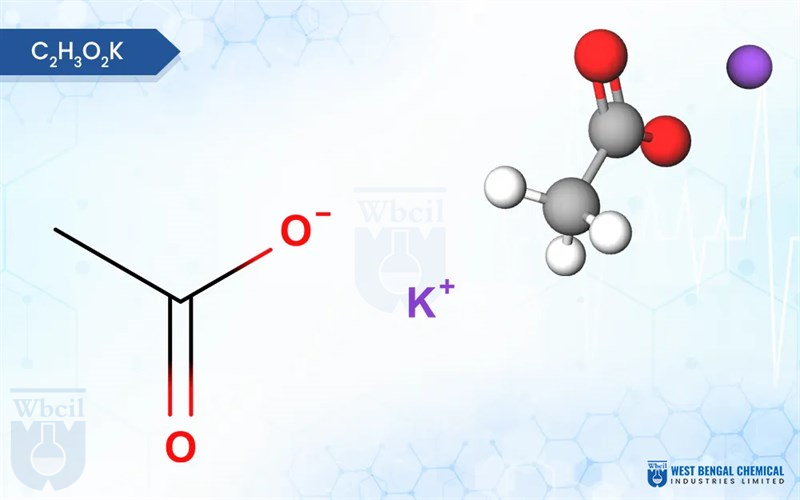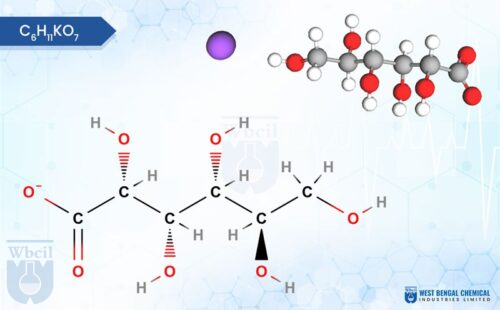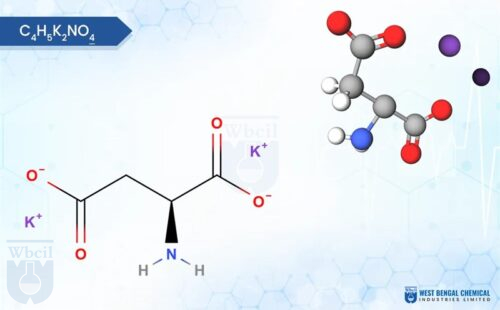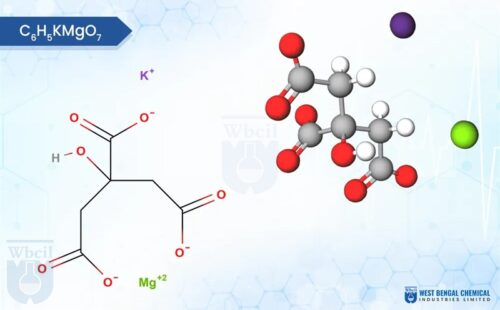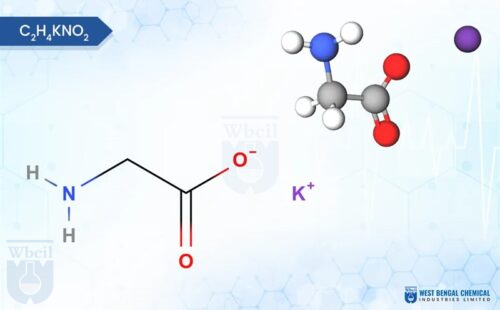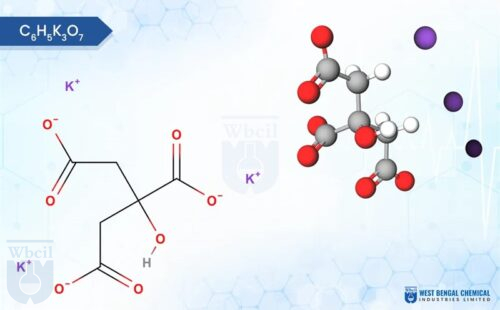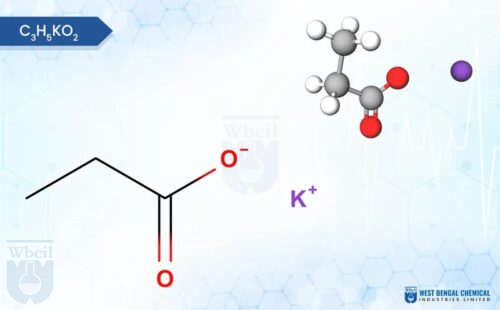-
Product Name:
Potassium Acetate
-
Molecular Formula:
C2H3O2K
-
Molecular Weight:
98.14 g/mol
-
CAS No.:
127-08-2
-
HSN Code:
29152910
-
CID Code:
517044
-
Shelf Life:
3 years - 20°C powder
-
ATC Code (WHO)
B05XA17
-
DrugBank ID
DB14498
-
ChemSpider ID
29104
-
UNII No.
M911911U02
- USP
- IUPAC Names
- Synonyms
- MSDS
USP of Potassium Acetate
- Maintains stable pH.
- Dissolves readily in water.
- Relatively non-toxic.
- Lowers freezing point of water.
- Absorbs moisture easily
- Approved for use in various foods.
IUPAC Names of Potassium Acetate
- potassium;acetate
- Potassium ethanoate
Synonyms of Potassium Acetate
- Potassium acetate
- Diuretic salt
- Acetic Acid, Potassium Salt
- Potassium ethanoate
- potassium;acetate
- Acetic acid, potassium salt
- Potassium acetates
- Acetic acid potassium salt
- Potassium acetate in plastic container
- Acetic acid (potassium 99%)
- Potassium acetate, for molecular biology
- potassiumacetate
- C2H3KO2
- Potassium acetate
- potasium acetate
- potassium acetat
- Acetate, Potassium
- potassium acetate ion
- CH3COOK
- Potassium Acetate, biochemical grade
- CAS-127-08-2
- Potassium acetate, Trace metals grade 99.98%
MSDS of Potassium Acetate
Download MSDS PDF- MSDS Name: Potassium Acetate
- Product Code: PAEIH99
- Relevant identified uses of the substance or mixture and uses advised against: Laboratory chemicals, Manufacture of substances, Food, drug, pesticide or biocidal product use.
- Eye Contact: Rinse immediately with plenty of water, also under the eyelids, for at least 15 minutes. Get medical attention.
- Skin Contact: Wash off immediately with plenty of water for at least 15 minutes. Get medical attention immediately if symptoms occur.
- Inhalation: Remove to fresh air. If breathing is difficult, give oxygen. Get medical attention immediately if symptoms occur.
- Ingestion: Do NOT induce vomiting. Get medical attention.
- Most important symptoms and effects: No information available.
- Notes to Physician: Treat symptomatically
- Suitable Extinguishing Media: Water spray, carbon dioxide (CO2), dry chemical, alcohol-resistant foam.
- Specific Hazards Arising from the Chemical: Dust can form an explosive mixture with air. Keep product and empty container away from heat and sources of ignition.
- Hazardous Combustion Products: Carbon monoxide (CO). Carbon dioxide (CO2). Potassium oxides.
- Protective Equipment and Precautions for Firefighters: As in any fire, wear self-contained breathing apparatus pressure-demand, MSHA/NIOSH (approved or equivalent) and full protective gear.
- Appearance form: Crystalline powder
- Color: White
- Taste: Saline and slightly alkaline test
- Odour: Odourless or faint acetous odour
- Solubility: Very soluble in water, freely soluble in alchohol
- pH (1 in 20 solution): 7.5 – 8.5
- Molecular weight: 98.15gm/mol.
- Other safety information: No data available
- Reactive Hazard: None known, based on information available
- Stability: Hygroscopic. Absorbs moisture from air and becomes liquid.
- Conditions to Avoid: Incompatible products. Excess heat. Avoid dust formation. Exposure to moist air or water.
- Incompatible Materials: Strong oxidizing agents
- Hazardous Decomposition Products: Carbon monoxide (CO), Carbon dioxide (CO2), Potassium oxides
- Hazardous Polymerization Incompatibilities: Hazardous polymerization does not occur.
- Hazardous Reactions: None under normal processing.
- https://whmis.org/sds/
- https://www.osha.gov/sites/default/files/publications/OSHA3514.pdf
- https://reachonline.eu/reach/en/annex-ii.html
- https://www.cdc.gov/niosh/npg/
- https://echa.europa.eu/da/registration-dossier/-/registered-dossier/15104
- https://pubchem.ncbi.nlm.nih.gov/compound/Potassium-Acetate
- https://en.wikipedia.org/wiki/Potassium_acetate
- https://www.chemicalbook.com/ChemicalProductProperty_EN_CB8690168.htm#:~:text=Potassium%20acetate%2C%20KC2H302%2C%20is%20a,and%20in%20crystal%20glass%20manufacture.

Description of Potassium Acetate
Potassium acetate, a chemical compound with the formula CH₃COOK, is a white crystalline solid that exhibits a hygroscopic nature, readily absorbing moisture from the atmosphere. Characterized by a faint acetic acid odor, it possesses a deliquescent property, transforming into a viscous liquid upon prolonged exposure to humidity. This salt is highly soluble in water and certain alcohols, while demonstrating insolubility in organic solvents like acetone and ether. As a potassium salt of acetic acid, it finds applications in diverse fields, including medicine, food processing, and fire suppression due to its ability to form a crust on burning oils. Chemically, potassium acetate is a crucial electrolyte replenisher and systemic alkalizer, playing a vital role in maintaining fluid balance and pH regulation within the body. As a leading API manufacturer, WBCIL prioritizes strict CGMP and ISO quality control measures throughout the production process. The prolonged experience from 1962 ensures consistent potency, purity, and safety in every dose of WBCIL’s Potassium acetate.
Application of Potassium Acetate
Food Industry:
- pH Stabilizer: Potassium acetate is used in the food industry as a pH buffer to maintain a stable and ideal pH level in food products, particularly in processed and preserved foods. This ensures product consistency, safety, and taste quality.
- Preservative: As an approved food additive, potassium acetate helps extend the shelf life of products by preventing spoilage through pH regulation. It is often used in canned foods, sauces, and other processed items.
- Humectant: Potassium acetate’s ability to absorb moisture makes it useful as a humectant in foods, helping to maintain moisture content and texture in products like baked goods and processed meats.
De-icing and Anti-icing in Aviation and Road Maintenance:
- De-icing Agent: Potassium acetate is commonly used as a de-icing and anti-icing agent, especially on airport runways and roads. It is favored because it lowers the freezing point of water, effectively preventing ice formation. Its environmental benefits and relatively non-toxic nature make it a safer alternative to traditional salts in sensitive areas.
- Corrosion Resistance: Compared to sodium chloride (road salt), potassium acetate is less corrosive to metal infrastructure and vehicles, making it preferable for use on roads, bridges, and in the aviation industry to prevent damage to equipment.
Pharmaceutical Industry:
- Buffer in Medical Solutions: Potassium acetate is used in the pharmaceutical sector as a buffering agent in medical solutions, ensuring that pH levels remain stable during production and administration. This is important for IV fluids and other medical treatments where pH balance is critical.
- Electrolyte Supplement: It also finds application as an electrolyte replenisher in some medications or IV treatments, helping to restore potassium levels in patients with deficiencies.
Chemical and Industrial Applications:
- Catalyst in Chemical Synthesis: Potassium acetate is used as a catalyst in certain chemical reactions, particularly in the synthesis of polyurethanes and other polymers, due to its solubility and stability.
- Heat Transfer Fluid Additive: In industries requiring heat exchange systems, potassium acetate is added to heat transfer fluids because it dissolves easily in water and helps maintain stable temperature control, lowering the freezing point of the fluid.
Environmental Applications:
Moisture Absorption: Potassium acetate’s hygroscopic properties (ability to absorb moisture) make it useful in various environmental applications, including moisture control in packaging, industrial environments, and storage facilities to prevent mold and degradation.


